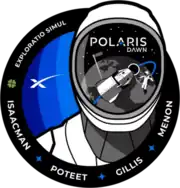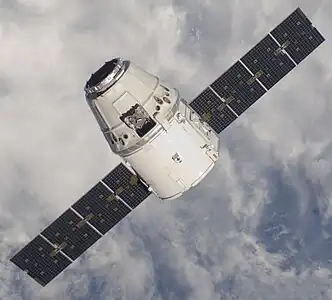 | |
| Mission type | Private spaceflight |
|---|---|
| Operator | SpaceX |
| Website | polarisprogram.com/dawn |
| Mission duration | 5 days (planned) |
| Spacecraft properties | |
| Spacecraft | Crew Dragon Resilience |
| Spacecraft type | Crew Dragon |
| Crew | |
| Crew size | 4 |
| Members | Jared Isaacman Scott Poteet Sarah Gillis Anna Menon |
| Start of mission | |
| Launch date | NET April 2024 (planned)[1] |
| Rocket | Falcon 9 Block 5 |
| Launch site | Kennedy Space Center, LC-39A |
| Contractor | SpaceX |
| Orbital parameters | |
| Periapsis altitude | 190 km (120 mi) |
| Apoapsis altitude | 1,400 km (870 mi) (initially) 750 km (470 mi) (later)[2] |
| Inclination | 51.6° |
 Mission Patch .jpg.webp) Isaacman, Poteet, Gillis, and Menon | |
Polaris Dawn is a planned private human spaceflight mission, operated by SpaceX on behalf of Shift4 Payments CEO Jared Isaacman,[3][4] scheduled to launch no earlier than April 2024.[1] The flight will be using a Crew Dragon capsule, and is the first of three planned missions in the Polaris program.[5]
History
The Polaris Dawn program was announced by Jared Isaacman in February 2022, five months after the first all-private astronaut mission, Inspiration 4, which was also financially backed by Isaacman.[6][7] Development of several technologies necessary for the mission is also part of the program, including extravehicular activity (EVA) spacesuits for private astronauts, intersatellite laser communication links between the Dragon spacecraft and the Starlink constellation, and some accommodation for the lack of an airlock in the legacy Dragon capsule design.[8]
Originally slated to fly as early as late 2022, the program suffered delays over the design of the EVA spacesuits and technical problems with SpaceX testing intersatellite laser communication links. By mid-2023, the planned date had slipped to sometime in 2024,[9] with Isaacman confirming in December a launch date of April 2024.[8] By October 2022, the launch had already slipped to March 2023,[10][11] and by February 2023, had slipped to no earlier than summer 2023.[12][13]
Mission
Polaris Dawn will be a human spaceflight to orbit Earth with only private citizens on board. The crew will consist of Jared Isaacman, Scott Poteet, Sarah Gillis, and Anna Menon, who will spend up to five days in orbit. Mission plans include reaching an orbit higher than any previous Dragon mission and ultimately the highest Earth orbit ever flown by a crewed spacecraft with an initial apogee of 1,400 km,[2][8] breaking the record set by Gemini 11.[14] The crew will conduct 38 science and research experiments to study the effects of spaceflight and space radiation on human health.[15] The crew will also attempt the first commercial EVA with SpaceX-designed EVA spacesuits,[16] as well as be the first crewed operational test of Dragon laser interlink communication via Starlink. If successful, it would potentially decrease communication latency and increase data bandwidth for human spaceflight.[17]
Crew
| Position | Astronaut | |
|---|---|---|
| Mission Commander | Second spaceflight | |
| Mission Pilot | First spaceflight | |
| Payload Specialist | First spaceflight | |
| Medical Officer | First spaceflight | |
Launch
See also
References
- 1 2 3 Howell, Elizabeth (December 11, 2023). "SpaceX private Polaris Dawn space mission delayed to April 2024". Space.com. Retrieved December 11, 2023.
- 1 2 "Scott Poteet Discusses Inspiration4 and Polaris Dawn Missions (Part 2)". May 9, 2022. Retrieved May 10, 2022.
- ↑ Clark, Stephen (14 February 2022). "Billionaire plans three more flights with SpaceX, culminating in Starship mission". Spaceflight Now. Retrieved 14 February 2022.
- ↑ "Jared Isaacman, who led the first all-private astronaut mission to orbit, has commissioned 3 more flights from SpaceX". The Washington Post. ISSN 0190-8286. Retrieved 2022-02-14.
- ↑ Sheetz, Michael (2022-02-14). "Billionaire astronaut Jared Isaacman buys more private SpaceX flights, including one on Starship". CNBC. Retrieved 2022-02-18.
- ↑ Davenport, Christian (February 14, 2022). "Jared Isaacman, who led the first all-private astronaut mission to orbit, has commissioned 3 more flights from SpaceX". The Washington Post. Retrieved November 20, 2023.
- ↑ Howell, Elizabeth (September 8, 2022). "SpaceX's private Polaris Dawn space crew talks about their ambitious mission". Space.com. Retrieved November 20, 2023.
- 1 2 3 4 Foust, Jeff (11 December 2023). "Polaris Dawn rescheduled for April". SpaceNews. Retrieved 11 December 2023.
- ↑ Foust, Jeff (August 22, 2023). "Polaris Dawn mission likely to slip to 2024". SpaceNews. Retrieved November 20, 2023.
- ↑ Howell, Elizabeth (January 30, 2023). "Polaris Dawn: The trailblazing commercial mission of the Polaris Program". Space.com. Retrieved November 20, 2023.
- ↑ Young, Chris (October 19, 2023). "SpaceX's private Polaris Dawn mission could launch by March 2023". Interesting Engineering. Retrieved November 20, 2023.
- ↑ Tribou, Richard (February 23, 2023). "Set for 2nd SpaceX flight, billionaire Isaacman all business about spacewalk for Polaris Dawn mission". Orlando Sentinel. Retrieved November 20, 2023.
- ↑ Lea, Robert (February 23, 2023). "SpaceX's private Polaris Dawn mission now targeting summer 2023 for launch". Space.com. Retrieved November 20, 2023.
- ↑ Sibu Kumar Tripathi (2022-02-15). "What is Polaris Dawn mission announced by SpaceX that launches Musk's astronaut corps?". India Today. Retrieved 2022-02-18.
- ↑ "Polaris Dawn Selects 38 Science and Research Experiments to Advance Human Health and Space Exploration". Polaris Dawn (Press release). PR Newswire. 24 October 2022. Retrieved 24 October 2022.
- ↑ Howell, Elizabeth (2022-02-14). "Meet the four private Polaris Dawn astronauts SpaceX will launch into orbit this year". Space.com. Retrieved 2022-02-18.
- ↑ "Starlink expanding, coming to Dragon capsule on Polaris Dawn, but NASA has concerns about the constellation". Space Explored. 2022-02-17. Retrieved 2022-02-18.

.jpg.webp)
